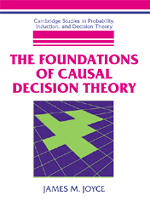Book contents
- Frontmatter
- Contents
- Preface
- Introduction: A Chance to Reconsider
- Chapter 1 Instrumental Rationality as Expected Utility Maximization
- Chapter 2 Decision Problems
- Chapter 3 Savage's Theory
- Chapter 4 Evidential Decision Theory
- Chapter 5 Causal Decision Theory
- Chapter 6 A General Theory of Conditional Beliefs
- Chapter 7 A Representation Theorem for Causal Decision Theory
- Chapter 8 Where Things Stand
- References
- Index
Chapter 2 - Decision Problems
Published online by Cambridge University Press: 25 July 2009
- Frontmatter
- Contents
- Preface
- Introduction: A Chance to Reconsider
- Chapter 1 Instrumental Rationality as Expected Utility Maximization
- Chapter 2 Decision Problems
- Chapter 3 Savage's Theory
- Chapter 4 Evidential Decision Theory
- Chapter 5 Causal Decision Theory
- Chapter 6 A General Theory of Conditional Beliefs
- Chapter 7 A Representation Theorem for Causal Decision Theory
- Chapter 8 Where Things Stand
- References
- Index
Summary
This chapter sets the stage for future developments by providing a formal characterization of the sorts of decision problems that agents face when choosing among alternative courses of action at a given time. The classic treatment of this subject, and the one still endorsed by most economists, can be found in Leonard Savage's masterpiece The Foundations of Statistics. A somewhat different characterization of decision making situations, which tends to find favor with philosophers, has been offered by Richard Jeffrey in The Logic of Decision. The model to be presented here will be a kind of hybrid of the Savage and Jeffrey approaches. It agrees with Savage in retaining a clear distinction among actions, states, and outcomes but follows Jeffrey in treating all three kinds of entities as species of propositions. The chief advantage of this mixed approach is that it allows us to be much more specific than Savage was about what the elements of decision problems actually are and how they relate to one another. It also gives us a general formal framework within which both evidential and causal decision theories can be conveniently expressed.
SAVAGE'S MODEL OF DECISION PROBLEMS
Savage's model envisions a decision maker, or agent, who chooses among risky or uncertain prospects, called actions, whose consequences or outcomes depend on the state of the world.
- Type
- Chapter
- Information
- The Foundations of Causal Decision Theory , pp. 48 - 77Publisher: Cambridge University PressPrint publication year: 1999

